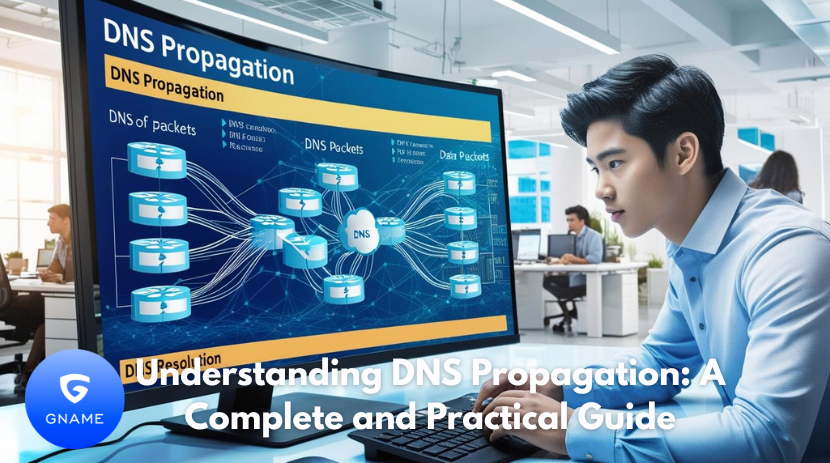Why your DNS changes don’t apply instantly—and what you can do about it Have you ever updated your domain's DNS settings—maybe to change your web host or update an email server—and then waited… and waited… for it to take effect? If so, you’ve already experienced DNS propagation in action. DNS propagation can be confusing, especially when changes seem to apply in one region but not another. In this guide, we’ll walk through what DNS propagation really is, why it takes time, and how you can manage it effectively to reduce disruptions.

What is DNS Propagation?
DNS propagation is the period of time it takes for changes to your domain's DNS records to spread and take effect across the entire internet. When someone visits your website, their browser asks a DNS resolver (usually provided by their ISP or public DNS service) for the IP address linked to your domain. If you recently changed your DNS records—like updating your nameservers or modifying your A record—it takes time for that change to be recognized and updated by all DNS servers worldwide.
Why Does It Take Time?
DNS isn’t a single database—it’s a distributed, hierarchical system with thousands of servers working together. Here's how it works:
- Your domain has authoritative DNS servers (typically from your hosting or registrar).
- Other DNS resolvers around the world query those authoritative servers to get DNS information.
- These resolvers store (cache) that info for a set amount of time, determined by a value called TTL (Time To Live).
- if you change your DNS records, your authoritative server updates immediately but the rest of the internet won’t see the change until their local cache expires and refreshes.
This delay in global sync is what we call DNS propagation.
Key Factors That Affect Propagation Time
Propagation can take anywhere from a few minutes to 48 hours—or longer. Here’s what influences the delay:
1. TTL (Time to Live) Settings
Each DNS record has a TTL value that tells DNS resolvers how long to keep the info cached before checking again.
- Shorter TTL (like 300 seconds) = faster propagation
- Longer TTL (like 86400 seconds or 24 hours) = slower updates but less load on servers
2. DNS Resolver Behavior
Different ISPs and public DNS services have different cache refresh policies. Some update records frequently, while others may hold onto cached info longer than expected.
3. Geographic Distribution
DNS servers in different regions may not update at the same pace. For example, users in Asia might see your new records before users in South America, depending on DNS resolver settings and traffic routing.
4. Record Type
Some DNS records (like A or CNAME) tend to propagate faster than others (like MX for email). Each record type might follow different caching behavior or processing queues depending on the service provider.
Common Misunderstandings About DNS Propagation
There are a lot of myths and confusion around this topic. Here are two big ones:
- “DNS changes always take exactly 24 or 48 hours.”
→ False. Propagation time is variable and depends on multiple factors. It can be as short as a few minutes or drag on for more than two days.
- “Once I update a record, everyone sees it immediately.”
→ Also false. DNS is cached globally, so two people in different locations may see different results for the same domain at the same time.
Best Practices for Managing DNS Changes
To reduce stress and disruption when making DNS updates, here are some best practices to follow:
✅ Lower the TTL Before Making Changes
A day or two before you make major changes, temporarily reduce the TTL on your DNS records (e.g., set it to 300 seconds). This ensures that DNS resolvers refresh more quickly after the change. Once everything is live and stable, you can raise the TTL again to a longer value.
✅ Make Changes During Off-Peak Hours
Try to update DNS during periods of lower traffic (like early morning or weekends) so fewer users are affected by inconsistencies or downtime.
✅ Monitor Propagation Progress Use online tools like:
- DNS Checker
- WhatsMyDNS
These tools show how your new DNS records are being picked up in different regions of the world.
✅ Notify Users if Necessary
If your DNS changes could affect access (like a new server or IP address), let your users know in advance. A quick email or notice on your site can go a long way in managing expectations.
Read more: Navigating the Web of Time: Exploring Old Domain Names
Final Thoughts: Plan Ahead, Stay in Control
DNS propagation might feel like a mysterious waiting game, but when you understand how it works, you can manage it with confidence. By planning ahead, adjusting TTL settings, and monitoring changes, you’ll minimize downtime and avoid unnecessary confusion. Whether you’re updating a website, moving servers, or configuring email, understanding DNS propagation is a must for any domain owner or web admin. So the next time your DNS change doesn’t "just work"—remember, it’s not broken. It’s just on its way.























